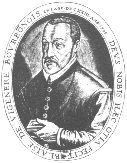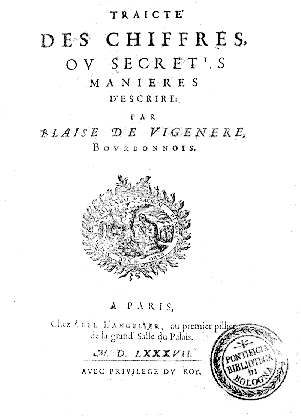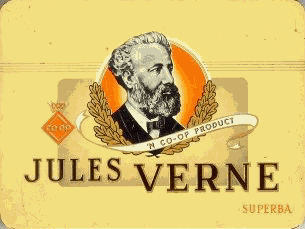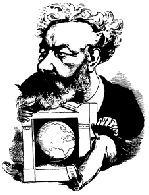
Blaise de Vigenere

How can we get rid of the tell tale fingerprints of the charactertistics frequencies?
POLYALPHABETIC SUBSTITUTION
Vigenere Cipher

Blaise de Vigenere |
 |
Idea: Use different
shifts for different characters in the message: The amount you shift depends
on the relative position of the character in the message
keyword:
VERMONT
| V | E | R | M | O | N | T | V | E | R | M | O | N | T | V | E | R | |
| M | I | D | D | L | E | B | U | R | Y | C | O | L | L | E | G | E |
| V | E | R | M | O | N | T | V | E | R | M | O | N | T | V | E | R |
| 22 | 5 | 18 | 13 | 15 | 14 | 20 | 22 | 5 | 18 | 13 | 15 | 14 | 20 | 22 | 5 | 18 |
| 13 | 9 | 4 | 4 | 12 | 5 | 2 | 21 | 18 | 25 | 3 | 15 | 12 | 12 | 5 | 7 | 5 |
| M | I | D | D | L | E | B | U | R | Y | C | O | L | L | E | G | E |
| 22 | 5 | 18 | 13 | 15 | 14 | 20 | 22 | 5 | 18 | 13 | 15 | 14 | 20 | 22 | 5 | 18 |
| 13 | 9 | 4 | 4 | 12 | 5 | 2 | 21 | 18 | 25 | 3 | 15 | 12 | 12 | 5 | 7 | 5 |
| 35 | 14 | 22 | 17 | 27 | 19 | 22 | 43 | 23 | 43 | 16 | 30 | 26 | 32 | 27 | 12 | 23 |
| 9 | 14 | 22 | 21 | 1 | 19 | 22 | 17 | 23 | 17 | 16 | 4 | 26 | 6 | 1 | 12 | 23 |
| I | N | V | U | A | S | V | Q | W | Q | P | D | Z | F | A | L | W |
| M | I | D | D | L | E | B | U | R | Y | C | O | L | L | E | G | E |
| I | N | V | U | A | S | V | Q | W | Q | P | D | Z | F | A | L | W |
OBSERVE:
D has been encrypted as V and as U
L has been encrypted as Z and as F
E has been encrypted as Aand as W
Ciphertext A came from L and E
Ciphertext W came from R and E
The resulting frequency distribution is much flatter.
Jules Verne & Vigenere Cipher
 |
 |
1881. La Jangada or Eight Hundred Leagues on the Amazon
SECURITY OF VIGENERE CIPHER
Once Thought Unbreakable.
French: "Le Chiffre Indechiffrable"
Used by Confederacy in Civil War
"Manchester Bluff"
"Come Retribution"
"Complete Victory"
Basis of German Enigma
Machine
Vigenere Cipher cracked by
Charles Babage (1854)
Friedrich W. Kasiski (1805 - 1881) (1863)
How to crack a Vigenere Cipher:
Determine length of keyword
Use frequency analysis
on subsets of the cipher text consisting of text enciphered with the same
shift.
Is There a Theoretically
Unbreakable Cipher?
One-Time Pad
(Gilbert Vernam)
Generate a sequence of random shifts (between 1 and 26) on a pad of paper and use them to encipher your plaintext.
Shift each character by the next shift on the pad. When you're done, mark your location in the pad. Start next message at the new location. Use the pad only once.
The One-Time Pad is a Vigenere cipher with an infinitely long randomly chosen keyword.
Example:
Random stream is 9,
26, 1, 7, 23, 15, 21, 14, 11, 11, 2, 8, 9, 21,...
| S | E | N | D | M | O | R | E | M | O | N | E | Y |
| 19 | 5 | 14 | 4 | 13 | 15 | 18 | 5 | 13 | 15 | 14 | 5 | 25 |
| 9 | 26 | 1 | 7 | 23 | 15 | 21 | 14 | 11 | 11 | 2 | 8 | 9 |
| 2 | 5 | 15 | 11 | 10 | 4 | 13 | 19 | 24 | 26 | 16 | 13 | 8 |
| B | E | O | K | J | D | M | S | X | Z | P | M | H |
In Theory: Completely
Secure
Practical Problems:
Pad must be randomly generated.
You and your friend need identical pads.
You must stay synchronized.
You must use the pad only once.
Creation, Distribution, and Storage of pads are a problem.
How many pads would the
State Department require?